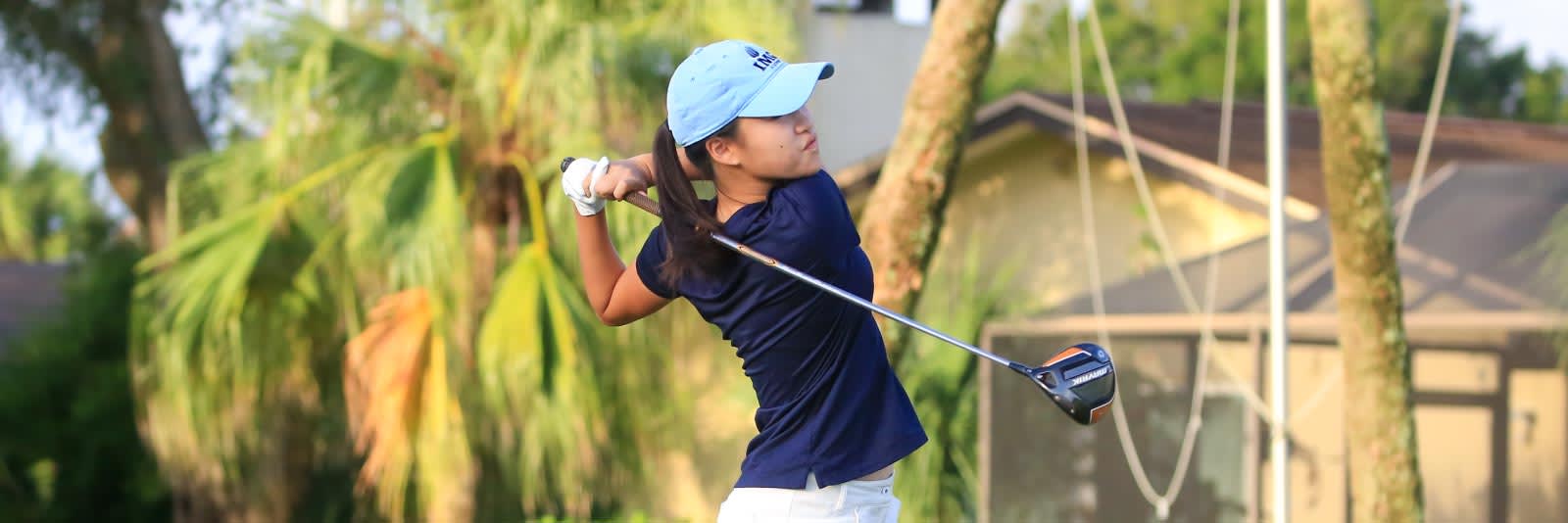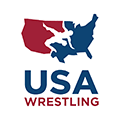Women’s Golf Recruiting Guidelines: How Good Do You Have to Be to Play College Golf?

Whether you have several years of tournament experience or are still nailing down the fundamentals, there are college golf opportunities across many programs, from NCAA Division 1 to the NAIA. But you may be wondering: exactly how good do you need to be to play college golf? Some divisions have more flexibility than others, and this section breaks down the requirements in each, so you can gain insight into what college coaches look for when recruiting student-athletes, including college golf scores.
Quick Links
How good do you have to be to play college women’s golf?
Of the 78,000 high school athletes who play golf, only 2.8 percent go on to compete at the NCAA Division 1 level, two percent at NCAA Division 2 and 2.1 percent at NCAA Division 3. Even more, if you look closely at the numbers, you’ll notice that women’s golf is one of the top five NCAA Division 1 sports that rosters international athletes. In fact, 11.7 percent of all NCAA golfers are international students and 20.1 percent play at the D1 level.
Student-athletes interested in playing collegiate golf need to do their homework and know what coaches are looking for in recruits. Most commonly, they focus on two aspects of a recruit’s golf game: their golf scores and national ranking/tournament experience. When analyzing a recruit’s potential, coaches will hand pick results from tournaments that are at least 6,000 yards and exclude anything less. They don’t really pay attention to high school results because college courses are much more difficult, and national tournaments more closely mirror the level of play needed.
Keeping that in mind, top Division 1 programs tend to recruit players with an average golf score of 75 and lower. Top Division 2 programs are also selective—college coaches at these schools look for golfers who average 80 or lower (some schools will only recruit athletes who average in the 70s). You’ll find the most flexibility among Division 3 and NAIA programs, which can range anywhere from 80 and below to up to 95.
In addition to evaluating a recruit’s best scores, coaches also like to see how they rank nationally. The most popular site they follow is Junior Golf Scoreboard. They will also look at tournament results through the American Junior Golf Association (AGJA) and Golfweek. The best junior golfers in the country earn high rankings on these sites and have top finishes at national and state events.
What type of national golf rankings do college coaches look at?
When it comes to golf college recruiting, coaches highly value national tournaments and rankings over high school events. The most popular site they follow is the Junior Golf Scoreboard, which compiles scores from more than 2,000 verified tournaments across the country. Some associations have their own ranking systems, like the American Junior Golf Association (AJGA) and Golfweek (mostly Midwest events), that college coaches are also familiar with.
To fully evaluate a golfer’s athletic ability, coaches validate golf scores by analyzing a recruit’s national ranking, assessing the course difficulty and determining their “tournament score differential.” Basically, they pull scores from multiple-day events that are at least 36 holes and compare how the recruit golfed each day. This gives them insight into the student-athlete’s mental toughness as well. For example, were they consistent each day or did they play poorly under pressure?
Families can do a quick search on Junior Golf Scoreboard to find out where verified tournaments are taking place. The best way to improve your national ranking, and possibly gain entry to other elite junior events, is to sign up for multiple-day tournaments that are at least 36 holes.
Then, you can also see how you stack up against college-athletes by following collegiate rankings on Golf Stat, which tracks individual and team rankings from NCAA Division 1 to NAIA.
Women’s NCAA golf scores and handicaps by division level
| Tier 1 | Tier 2 | Tier 3 | Tier 4 | |
| High NCAA D1 | Low NCAA D1 | NCAA D2 and Top NAIA | NCAA D3 and Low NAIA | |
| Tournament Handicap* | Maximum of 3 | Maximum of 8 | Maximum of 12 | Maximum of 20 |
| Scoring Average | 75 and below | 80 and below | 85 and below | 95 and below |
| Tournament Experience | Top finishes at the national and state level. Several years competing at AJGA, USGA and state tournaments, resulting in a high national ranking. Full summer golf schedule with multiple-day tournaments. | Competes at the regional and state levels. Acquired a national ranking. May have earned high school recognition such as, First or Second-Team All-State. | Competes at the regional and state levels. Experience competing in multiple-day event tournaments. May have earned high school recognition, such as All Conference or All District. | Competes in state and local tournaments. |
Remember that student-athletes who fall outside of these guidelines can still be recruited by college coaches.
*Tournament Handicap: Handicaps have become an outdated statistic in the college golf recruiting guidelines—mostly because student-athletes can easily manipulate their handicap by hand picking the events they attended. Or in some cases, they can enter fabricated scores into the system. If a college coach does consider a recruit’s handicap, they only compute scores at nationally ranked tournaments. Bottom line: Golf scores are more important, especially those from tournaments that are 36 holes or more.
What are the average golf scores for women’s golf?
College coaches analyze golf scores at many different angles. First, they rarely consider scores from courses that are less than 6,000 yards, as college courses typically range from 6,000 to 6,300 yards. Then, they factor in course difficulty. High school golf events, which are usually 9 or 18 holes, are typically overlooked by women’s golf coaches. Instead, they seek out recruits at national tournaments where the level of play more closely mirrors the college landscape and truly tests their mental and athletic skill set.
Lastly, college coaches sort through tournament results from each day to determine a recruit’s “tournament score differential.” This helps them evaluate how a student-athlete competes under pressure and whether they can bounce back from an off day.
Keeping that in mind, here are the average scores coaches look for in a recruit for every division:
- NCAA Division 1 women’s golf scores – 70 to 80
- NCAA Division 2 women’s golf scores – 75 to 85
- NCAA Division 3 women’s golf scores – 80 to 95
- NAIA women’s golf scores – 80 to 95
What handicap do you need to play women’s college golf?
Handicaps have become an outdated statistic in the college golf recruiting guidelines—mostly because student-athletes can easily manipulate their handicap by hand picking the events they attended. If a college coach does consider a recruit’s handicap, they only compute scores at nationally ranked tournaments.
- D1 women’s golf handicap – Maximum of 3
- D2 women’s golf handicap – Maximum of 8
- D3 women’s golf handicap – Maximum of 12
- NAIA women’s golf handicap – Maximum of 20
The importance of golf tournaments in recruiting
Women’s golf coaches rely on tournaments and tours, as well as national rankings, to recruit the best student-athletes from across the country. When it comes down to it, high school tournaments just don’t compare to the competitive college landscape. Instead, coaches focus on multiple-day tournaments that are at least 6,000 yards to find the student-athletes who can compete at their program.
- State Golf Association Championships: Most state golf associations host advanced level junior events throughout the calendar year. They can be an affordable way for student-athletes to attend multiple-day events and garner interest from coaches in their area.
- Junior Golf Scoreboard: The best way for a student-athlete to improve their national ranking is by attending multiple day tournaments verified by Junior Golf Scoreboard. While Florida, Georgia, South Carolina, Texas, California and Arizona host several competitive tours, there are more than 2,000 tournaments across the country that student-athletes can participate in.
- National Golf Tours: All college coaches are familiar with the American Junior Golf Association (AJGA), Future Collegians World Tour (FCWT) and the International Junior Golf Tour (IJGT), which offer multiple-day competitions across the country. However, they can be expensive and require a membership to attend.
- United States Golf Association (USGA) Championships. The most prestigious junior and amateur golf competitions in our country are conducted by the United States Golf Association. Qualifying for these events can be extremely difficult.
Many college coaches like to recruit from a specific tournament or a particular region every year. Visit the college team’s roster and do a little digging. What state or region are the athletes from? What is their tournament and score history? Getting a little background on the current players can provide key insight into the coach’s recruiting methods.
How coaches evaluate your golf swing
The best way to showcase your golf swing to college coaches is to send them a swing video. Many coaches don’t have the budget or time to watch recruits play or practice at a competition site. While it won’t capture every aspect of your golf game, a swing video can be a highly effective way of communicating with a coach and landing a second, more in-depth evaluation. If it’s done correctly, your video will be about 10 minutes long and will capture a wide variety of swings and club selections from different parts of the course, including:
- Swings with a short iron/wedge, swings with a mid/long iron and swings with driver from both a “down the line” and “face on” angle
- Include several chips, pitches and bunker shots from these angles, as well
- Short, medium and long putts from both angles
- Straight putts from five to 10 feet from both angles
It’s important for recruits to email their swing video, along with their online profile, to college coaches.
















